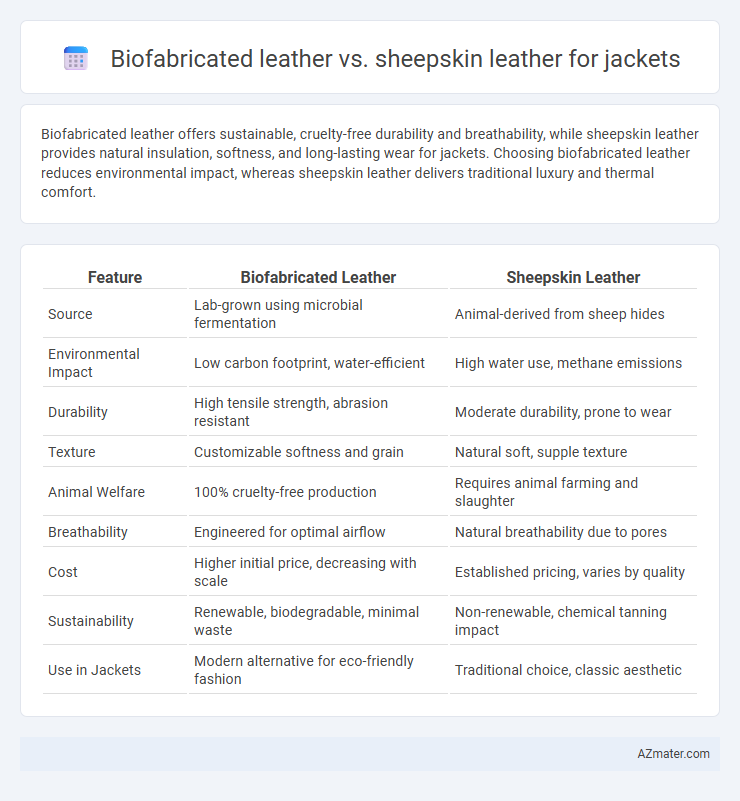Biofabricated leather offers sustainable, cruelty-free durability and breathability, while sheepskin leather provides natural insulation, softness, and long-lasting wear for jackets. Choosing biofabricated leather reduces environmental impact, whereas sheepskin leather delivers traditional luxury and thermal comfort.
Table of Comparison
| Feature | Biofabricated Leather | Sheepskin Leather |
|---|---|---|
| Source | Lab-grown using microbial fermentation | Animal-derived from sheep hides |
| Environmental Impact | Low carbon footprint, water-efficient | High water use, methane emissions |
| Durability | High tensile strength, abrasion resistant | Moderate durability, prone to wear |
| Texture | Customizable softness and grain | Natural soft, supple texture |
| Animal Welfare | 100% cruelty-free production | Requires animal farming and slaughter |
| Breathability | Engineered for optimal airflow | Natural breathability due to pores |
| Cost | Higher initial price, decreasing with scale | Established pricing, varies by quality |
| Sustainability | Renewable, biodegradable, minimal waste | Non-renewable, chemical tanning impact |
| Use in Jackets | Modern alternative for eco-friendly fashion | Traditional choice, classic aesthetic |
Introduction to Biofabricated and Sheepskin Leather
Biofabricated leather, developed through cellular agriculture, offers a sustainable alternative by growing collagen proteins in labs to mimic conventional leather's texture and durability. Sheepskin leather, derived from sheep hide, is valued for its softness, breathability, and natural insulating properties, making it a traditional choice for high-quality jackets. Comparing their environmental impact and performance highlights biofabricated leather's potential to reduce resource consumption while maintaining the tactile appeal of natural sheepskin.
What is Biofabricated Leather?
Biofabricated leather is an innovative, sustainable material produced by growing collagen fibers through microbial fermentation, replicating the structure and feel of traditional animal leather without harming animals. Unlike sheepskin leather, which is derived from tanned sheep hide, biofabricated leather offers a cruelty-free alternative with a significantly lower environmental footprint, including reduced water usage and greenhouse gas emissions. This cutting-edge technology enables the creation of durable, breathable, and customizable leather products ideal for jackets while addressing ethical and ecological concerns associated with conventional sheepskin leather.
Sheepskin Leather: Traditional and Timeless
Sheepskin leather offers a traditional and timeless appeal with its natural softness, durability, and breathability, making it an enduring choice for jackets. Its unique grain and ability to develop a rich patina over time enhance both comfort and aesthetic value, distinguishing it from biofabricated leather alternatives. This classic material remains favored for its insulation properties and authentic, luxurious feel that synthetic options struggle to replicate.
Environmental Impact: Biofabricated vs Sheepskin
Biofabricated leather reduces environmental impact by using less water, land, and chemicals compared to traditional sheepskin leather, which relies on livestock farming known for high greenhouse gas emissions and deforestation. The production of biofabricated leather generates fewer pollutants and consumes less energy, supporting sustainable fashion trends. In contrast, sheepskin leather contributes to soil degradation and waste management challenges due to the tanning processes involved.
Durability and Quality Comparison
Biofabricated leather offers superior durability compared to traditional sheepskin leather due to its engineered structure that resists wear, tear, and environmental damage. The quality of biofabricated leather excels with consistent thickness, fewer imperfections, and enhanced water resistance, providing a long-lasting, premium finish ideal for jackets. In contrast, sheepskin leather, while naturally soft and breathable, can be prone to scratches, fading, and requires regular maintenance to preserve its durability and appearance.
Aesthetic Differences and Design Flexibility
Biofabricated leather offers a uniform texture and consistent coloration, allowing designers to experiment with bold, innovative patterns and finishes that are difficult to achieve with traditional sheepskin leather. Sheepskin leather features natural grain variations and wrinkles, providing a distinctive, authentic aesthetic that appeals to those seeking classic, timeless jacket styles. Design flexibility is enhanced in biofabricated leather due to its customizable thickness and surface properties, whereas sheepskin leather's variable thickness and rigidity limit its manipulation and design options.
Comfort and Wearability in Jackets
Biofabricated leather offers superior breathability and flexibility compared to traditional sheepskin leather, enhancing overall comfort in jackets. Its hypoallergenic and moisture-wicking properties reduce irritation and sweat buildup, making it ideal for prolonged wear. Sheepskin leather provides durable insulation and natural softness but may require more maintenance to retain comfort and flexibility over time.
Ethical Considerations in Leather Sourcing
Biofabricated leather offers a sustainable alternative to sheepskin leather by eliminating animal harm and reducing environmental impact associated with livestock farming. Ethical considerations favor biofabricated leather due to its cruelty-free production, minimized water usage, and lower greenhouse gas emissions compared to traditional sheepskin sourcing. Consumers seeking animal-friendly and eco-conscious fashion increasingly prefer biofabricated leather jackets for responsible material choices.
Price Comparison: Biofabricated vs Sheepskin Jackets
Biofabricated leather jackets typically command higher prices compared to sheepskin jackets due to advanced production technologies and sustainability benefits. Sheepskin leather jackets are generally more affordable, benefiting from established supply chains and traditional tanning processes. Consumers may weigh the upfront cost difference against long-term environmental impact and durability when choosing between biofabricated and sheepskin leather jackets.
Future Trends in Sustainable Leather Alternatives
Biofabricated leather offers a cutting-edge sustainable alternative to traditional sheepskin leather by minimizing environmental impact through lab-grown materials that reduce reliance on animal farming and lower carbon emissions. Innovations in biofabrication techniques are driving scalability and durability improvements, positioning this material as a viable option for eco-conscious fashion brands targeting the jacket market. Advances in circular economy integration and biodegradable composites further enhance biofabricated leather's appeal, signaling a strong future trend toward sustainable leather alternatives.

Infographic: Biofabricated leather vs Sheepskin leather for Jacket
 azmater.com
azmater.com